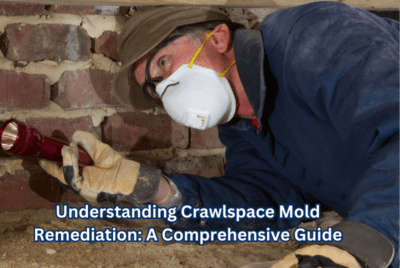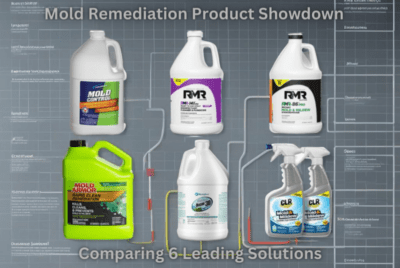Attic Mold Removal: Say Goodbye to Mold for a Healthier Home
If you’re facing the issue of attic mold, you’ve come to the right place. In this article, I’ll guide you through the process of understanding attic mold, the importance of its removal, and provide helpful suggestions for tackling this problem. Attic mold is a common issue that can affect the air quality of your home and pose health risks. Let’s dive in and explore effective strategies to deal with this problem.
| Key Takeaways |
| 1. Attic mold can pose serious health risks & compromise your home’s integrity. Address it promptly to prevent further damage. |
| 2. Consider professional mold remediation for effective and long-term results. Seek expert assistance for extensive or recurring mold. |
| 3. Actively monitor your attic for musty odors, discoloration & visible mold growth. Early detection facilitates easier removal. |
| 4. Proper ventilation, moisture control & insulation are crucial in preventing attic mold. Create a healthy environment for your home. |
| 5. Prioritize safety during DIY mold removal. Wear protective gear & ensure proper airflow. When in doubt, consult professionals. |
Understanding Attic Mold
Causes of Attic Mold
Attic mold thrives in environments with excessive moisture, poor ventilation, and organic materials like wood or insulation. Common causes include roof leaks, condensation, high humidity, and inadequate airflow.
Health Risks Associated
The presence of mold in your attic can lead to various health issues such as allergies, respiratory problems, and even infections. Mold spores can become airborne and circulate throughout your home, impacting the well-being of your family.
Signs of Attic Mold
Identifying attic mold early is crucial for effective remediation. Keep an eye out for musty odors, discoloration on the walls or ceiling, peeling paint, or visible mold growth. Attics tend to harbor slightly higher air temperatures and experience an accumulation of moisture or humidity that ascends from the rest of your home. It’s worth noting that orange mold particularly relishes wood, making it a preferred source of sustenance for its growth and propagation. If you notice any of these signs, it’s essential to take prompt action.
Importance of Attic Mold Removal
Preventing Further Damage
Attic mold can cause structural damage to your home if left untreated. It can deteriorate the integrity of the wood, insulation, and other materials, leading to costly repairs in the future. Timely removal prevents the spread of mold and avoids extensive damage.
Enhancing Indoor Air Quality
The air quality inside your home is directly affected by attic mold. Mold spores can contaminate the air, causing respiratory problems and allergies. Removing the mold improves indoor air quality and creates a healthier living environment.
DIY Attic Mold Removal Tips
Safety Precautions
Before starting any mold removal process, prioritize safety. Wear protective gear, including gloves, goggles, and a respirator, to prevent exposure to mold spores. Ensure proper ventilation during the cleaning process.
Assessing the Situation
Thoroughly inspect your attic to identify the extent of the mold growth. Determine whether the affected area is manageable for DIY removal or if professional intervention is necessary.
Cleaning and Disinfecting
For small-scale mold problems, you can remove the mold yourself. Scrub the affected surfaces using a mixture of water and detergent or a specialized mold cleaner. Dry the area thoroughly and monitor it for any signs of recurrence.
Hiring Professional Mold Remediation Services
Expertise and Experience
When dealing with extensive mold growth or recurring mold issues, it’s advisable to seek the expertise of professional mold remediation services. Certified mold remediation experts have the knowledge and experience to handle complex situations. They understand the different types of mold, their growth patterns, and the appropriate methods for safe removal.
Advanced Equipment and Techniques
Professional mold remediation companies utilize specialized equipment and techniques to effectively eliminate attic mold. They have access to advanced tools such as air scrubbers, HEPA vacuums, and moisture meters to assess the extent of the mold growth and ensure thorough remediation. These professionals employ industry-approved techniques to prevent cross-contamination and ensure a successful mold removal process.
Long-Term Solutions
While DIY methods may temporarily address the mold problem, professional services provide long-term solutions. Mold remediation experts not only remove the existing mold but also identify and address the root causes. They will assess the attic’s ventilation, insulation, and moisture control to prevent future mold growth, ensuring a healthier and mold-free environment for your home.
Preventing Attic Mold
Prevention is key when it comes to attic mold. By taking proactive measures, you can significantly reduce the chances of mold growth in your attic.
Proper Ventilation
Ensure proper attic ventilation to promote airflow and reduce moisture accumulation. Install vents or fans to facilitate air circulation and remove excess humidity. Proper ventilation helps maintain a dry environment that discourages mold growth.
Controlling Moisture Levels
Monitor and control the moisture levels in your attic. Fix any roof leaks promptly and insulate pipes to prevent condensation. Use a dehumidifier if necessary, especially in humid climates or during damp seasons. By keeping the humidity in check, you can inhibit mold growth.
Insulation and Sealing
Proper insulation and sealing play a crucial role in preventing attic mold. Insulate your attic properly to regulate temperature and reduce the likelihood of condensation. Seal any gaps or cracks that can allow moisture entry. By creating a well-insulated and sealed attic, you create an environment that discourages mold growth.
Conclusion
Attic mold removal is essential for maintaining a healthy and safe living environment. By understanding the causes, health risks, and signs of attic mold, you can take proactive steps to prevent its growth. If faced with attic mold, consider the extent of the problem and your comfort level with DIY methods. For extensive or recurring mold issues, hiring professional mold remediation services ensures effective and long-term solutions. Remember to prioritize safety during mold removal, and always address the underlying causes to prevent future mold growth. By following these suggestions, you can protect your home and ensure a mold-free attic.
FAQs
1. How do I know if I have attic mold?
Signs of attic mold include musty odors, discoloration on walls or ceilings, peeling paint, and visible mold growth. If you notice any of these signs, it’s recommended to further investigate the issue.
2. Can I remove attic mold myself?
For small-scale mold problems, DIY removal can be an option. However, extensive mold growth or recurring mold issues may require professional mold remediation services.
3. How long does the attic mold removal process take?
The duration of the mold removal process depends on the extent of the mold growth and the remediation methods employed. It can range from a few hours to several days.
4. Will attic mold come back after removal?
Proper remediation techniques and addressing the root causes significantly reduce the chances of mold recurrence. However, it’s essential to monitor the attic for any signs of moisture or mold growth in the future.
5. How much does professional mold remediation cost?
The cost of professional mold remediation varies based on factors such as the size of the affected area, the severity of the mold growth, and the location. It’s best to contact local mold remediation companies for a detailed assessment and cost estimate.
6. Are there any natural remedies for attic mold removal?
While some natural remedies like vinegar or hydrogen peroxide can help with small-scale mold problems, they may not be as effective for extensive mold growth. It’s important to assess the situation and consider professional assistance for thorough remediation.
7. Can attic mold affect my health?
Yes, attic mold can pose health risks. Mold spores can become airborne and cause allergies, respiratory issues, and infections. Prompt removal and addressing the underlying causes are crucial for maintaining a healthy living environment.
8. How can I prevent attic mold from recurring?
To prevent attic mold from recurring, ensure proper ventilation, control moisture levels, and maintain proper insulation and sealing in the attic. Regular inspections and prompt action in case of any signs of moisture or mold growth are also important.
9. Can I use bleach to remove attic mold?
While bleach can kill mold on non-porous surfaces, it may not be effective for porous materials like wood or insulation. It’s best to consult professionals or use specialized mold cleaners recommended for attic mold removal.
10. Will attic mold affect my home’s resale value?
The presence of attic mold can potentially impact the resale value of your home. It’s advisable to address the mold issue and provide proper documentation of remediation efforts to potential buyers.
Remember, attic mold removal requires careful attention and proper remediation techniques. Whether you choose to tackle it yourself or hire professionals, prioritizing safety and long-term solutions is vital for a mold-free and healthy home.





